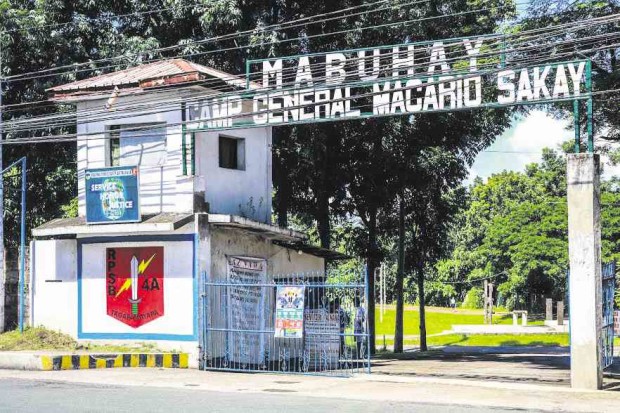Camp’s name change is first step to correct history

Camp Eldridge in Los Baños, Laguna, is now Camp General Macario Sakay in honor of a forgotten hero of the Philippine military. —AMIEL JOB LIWANAGAN/CONTRIBUTOR
LOS BAÑOS, LAGUNA—Except for a steel arch announcing the name of Gen. Macario Sakay, there is nothing emblematic about the heroism of the Filipino revolutionary leader inside a military camp in this town in Laguna province.
No statue or bust, not even a single portrait of the freedom fighter who took to his grave false accusations of being a tulisan (bandit).
No wonder when you ask around Los Baños where Camp Sakay is, even older residents give quizzical responses.
“Where is that?” resident Rea Cabanilla said.
“Isn’t that the village inside UPLB (University of the Philippines Los Baños)?” another said, referring to a private campus subdivision called Sacay.
Unfortunately, to some, the name does not even ring a bell.
Long-haired hero
Born in Tondo, Manila, in 1870, Macario de Leon Sakay was one of the less prominent heroes in Philippine history.
Written accounts of his life said he had worked in a calesa (horse-drawn carriage) shop and was a tailor and a stage actor before joining the underground society called Katipunan.
When US President Theodore Roosevelt declared the end of the war between the Philippines and the United States in 1902, Sakay continued the fight for independence. He led brief but successful operations in southern Tagalog from 1902 to 1906, until American forces captured him and sentenced him to death by hanging on Sept. 13, 1907.
“We know so little about him because he was demonized by the Americans. He was accused of being a bandit,” Lt. Col. Ronald Jess Alcudia said.
In 2007, the government commemorated Sakay’s centenary at UP Diliman in Quezon City. This piqued Alcudia’s interest to study Sakay’s story.
In a paper, Alcudia described Sakay as a “forgotten AFP (Armed Forces of the Philippines) hero.”
“The Americans’ black propaganda of Sakay as a bandit was very successful in that even present-day soldiers have ingrained in their consciousness the Sakay-look (long-haired and unkempt) as that of a fearsome bandit,” he wrote.
To rectify this part of history, Alcudia proposed that a military camp in Barangay Lalakay here be renamed Camp Sakay.
The 12-hectare camp had been widely known as Camp Eldridge, often used by residents as a point of reference when giving directions. Named after American serviceman George Eldridge, who fought during the American-Indian war, the camp used to be a horse stable of American soldiers built around the time that UPLB was established.
Currently, the facility houses the AFP’s 403rd (Laguna) Community Defense Center, headed by Alcudia, and a unit of the Philippine National Police.
“Ironically, Sakay was hunted down by the Philippine Scouts and Philippine Constabulary, the forerunners of the AFP and the PNP, respectively,” Alcudia said.
His proposal went through tight scrutiny that it was only on Dec. 28 last year that then Defense Secretary Voltaire Gazmin approved the camp’s new name.
On Sept. 13, the National Historical Commission of the Philippines and the Philippine Veterans Affairs Office led a ceremony officially recognizing the camp’s new name in time for Sakay’s 109th death anniversary.
Bust
“It’s about time we correct history,” said Daniel Sakay, 80, a second-generation grandson of the late general.
Daniel, who was interviewed by telephone from his home in Quezon City, said many of their relatives fled Manila during the war and changed their names into Magsakay, Masangkay or Sacay to evade arrests by American soldiers.
Daniel said “Sakay” was the family name of the general’s mother, but it was not clear why he did not carry his father’s.
Perhaps out of fear of being associated with the “bandit,” very little of Sakay’s biography was recorded, even within the family.














